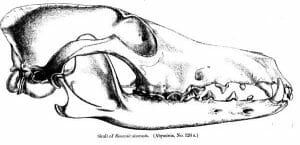Zygomatic Arch Definition
The zygomatic arch, cheek bone, or zygoma are all interchangeable terms for the structure in the skull seen indicated by the arrow in the following image. The zygomatic arch is formed from parts of both the zygomatic bone and the temporal bone. The extension of the temporal bone is known specifically as the zygomatic process, and attaches directly to the similarly shaped process on the zygomatic bone. The two extensions effectively make a tunnel of bone through which muscle and tendon can pass.
The zygomatic arch is seen in all synapsid animals, which have a single temporal fenestra or hole in the temporal bone. While ancestral mammal-like reptiles had a clear hole in the side of the skull, the temporal fenestra of modern mammals often molds with the orbit, which houses the eye. This can be seen in the following drawing of an Ethiopian wolf skull. Note how the eye socket, or orbit, connects directly with the zygomatic arch, unlike in primate and other human skulls.
In either case, the zygomatic arch functions as a structure that allows the attachment of various tissues to the skull. The hole allows the temporalis muscle and its associated tendons to pass under the zygomatic arch and attach the mandible bone to the skull. The tendons of the Temporalis muscle attach to the coronoid process, a small extension of the mandible which tucks under the zygomatic bone. The much larger masseter muscle which is used for moving the jaw, attaches directly to the zygomatic arch, and the other side to the large part of the mandible. This muscle provides most of the motion of the jaw, while the temporalis muscle provides extra tension on the jaw to grind, chew, strip and mash food. The zygomatic arch and associated structures provide a large surface area for these muscles to attach.
If you are chewing a piece of gum, you can feel both of these muscles working as you chew. Place your fingers between your eye and ear, and feel for the hard bone. As you chew, the masseter muscle will flex on the bottom side of the bone while the temporal muscle will flex and bulge on your skull above the zygomatic arch. Both of these muscles are needed to complete the complex action of chewing, which only mammals are capable of. Other animals (fish, birds, lizards, snakes) are all limited by the size of their mouth, which limits the size and types of food they can access. Some, like sharks, have developed sharp teeth to tear large chunks from prey, but the chunks are not chewed before swallowing. Mammals use the special adaptation of the zygomatic arch to grind and chew mouthfuls of food at a time. This both increases the speed of digestion and allows mammals to expand their diet to almost any food they can take a bite out of and chew up.
Related Biology Terms
- Temporal Bone – The bone at the base of the skull, part of which forms the zygomatic arch, which allows for the connections of the masseter and temporalis muscles from the skull to the mandible.
- Zygomatic Bone – The bone that forms the bottom part of the orbit and part of the zygomatic arch.
- Mandible – The large bone which makes up the jaw, and attached to the skull at a hinge point below the zygomatic arch.
- Coronoid Process – A small triangular extension of the mandible which provides a connection point for the temporalis muscle.
Quiz
1. A paleontologist is comparing two skulls, supposedly from primitive mammals. Skull 1 skull has a very large zygomatic arch in relation to the rest of the skull, while Skull 2 has a much less dramatic zygomatic arch. What does this tell the paleontologist about each skull?
A. Skull 1 is a more advanced mammal than Skull 2
B. Skull 1 probably had to chew and bite more than Skull 2
C. Skull 1 was simply a larger animal, therefore it has a bigger arch.
2. Gnarly spill, Dude! You just wrecked your bike trying to jump down a huge staircase. The doctor says you broke the zygomatic process of your temporal bone, so it’s going to be only smoothies for a few months as the bone heals. You didn’t break your jaw or get any dental work done, so why can’t you eat solid food?
A. The zygomatic arch is where the masseter connects
B. The temporal bone pushes on the hunger center of the brain if broken
C. It’s just a stupid precaution, you’ll still be able to eat.
3. If the zygomatic arch allows for muscle attachment, and reptiles and birds lack these structures, is it impossible for a bird or reptile to have a powerful jaw?
A. Yes
B. No
C. Yes, with minor exceptions
Zygomatic Arch


No comments:
Post a Comment